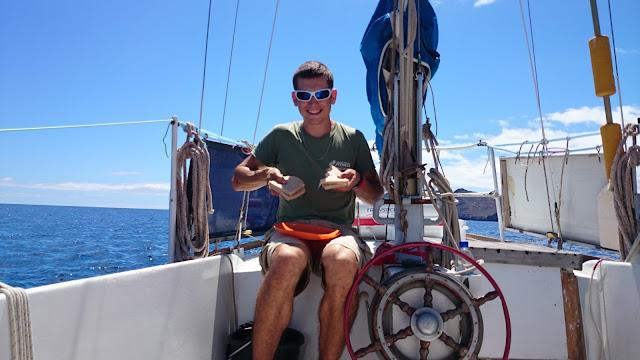Our last blog post may have caused some confusion, for which we apologise. In describing our maiden voyage in Seahorse, Alex was reflecting back on the trip which took place in the summer of 2014. We have not moved her from Lanzarote since, although we plan on doing so very soon.
In my last post, I described our plan to move to a boatyard in Gran Canaria at the start of November. Well, perhaps unsurprisingly, our plan has changed and this is no longer the case. Seahorse is currently still on Lanzarote. When discussing our plans with another yachtie at the marina, we discovered that he had experienced problems with the yard on Gran Canaria, with respect to being allowed to work on his own boat (or not, as the case may be). Given the fact that we plan on doing most of the work ourselves, and had not been able to obtain explicit permission from the yard that we would be able to do this, we decided not to take the risk and cancelled our reservation.
Back to square one, we began looking for other suitable boatyards in the Canaries, which would definitely let us work on Seahorse ourselves. By happy coincidence, a day or so later, a yacht arrived on the pontoon opposite us with a familiar face aboard. It was Fran, a friend of Firebird's new owner on Tenerife, who was sailing on a yacht with two other friends around the islands. It was really nice to catch up with him, and meet his friends. Through chatting with them over the course of their stay, we learned that the yacht they were sailing on had spent time in the boatyard at Marina San Miguel on Tenerife, and the owner had found it to be a very good yard which allowed owners to live aboard and do the work themselves. We had enjoyed our stay in the marina itself whilst on Firebird (although, it is slightly isolated and at the bottom of a rather large hill) and so this became a viable option for us to consider.
Fran spoke to the marina manager on our behalf, and discovered that they would have room for us in the yard from the end of December. He also told us that he knew of another steel boat who had spent time in the yard, and would be able to recommend a very good welder if we should need one. We really started to feel positive about going to Tenerife, which has a wealth of chandleries and supplies in the capital Santa Cruz, and where we would have some local friends who may be able to help us in terms of valuable local knowledge. Our plan began to evolve into staying in Lanzarote until our mooring expired (7th December) and then setting sail for Tenerife.
 |
| Alex enjoying unlimited buffet breakfast for only €12 each at the Arrecife Gran Hotel, having reached our 300kg milestone |
As well as shifting weight, we have a good deal more space on board now, and can now sleep in the forward cabin at night – luxury! For a while, this meant being unable to sit in the saloon, with the benches being taken up by sails, but we soon cleared enough space in the aft cabin to accommodate these. Additionally, Alex installed our decent foot pump in the galley and we filled the water tank, meaning we now have running water! Progress indeed. She is slowly taking shape, and becoming a lot easier to live aboard. Of course, this will all change once we get her to the yard and start pulling her to pieces, but for the time being our quality of life has much improved.
So, December is fast approaching and we will soon be on our way again. Hopefully our next voyage will be less eventful than our maiden one, and perhaps we will even be able to raise our sails on this trip! We hope that we can coax our ageing engine into service for us just a few more times, to help us reach our destination, whereby we can retire it and eventually replace it with our new Beta engine. Exciting times, and a good deal of hard work ahead of us, which we are eager to begin. No doubt it will be the New Year before we can really start our refit in earnest, but just to have arrived at the boatyard where the work will be taking place will feel like a big step forward for us, and one that I very much look forward taking.








